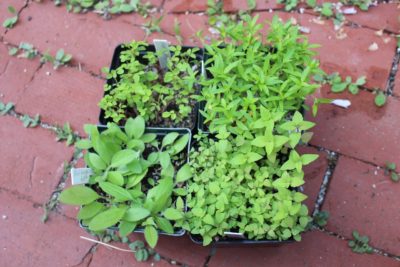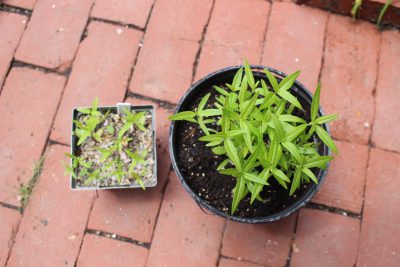Caring for your Native Seedlings
by Heather McCargo
How to grow them over the summer and plant into their permanent home in the fall
You have successfully germinated some native seeds and have small pots or flats filled with baby plants. Now what do you do?
I recommend growing first year seedlings in pots all summer and waiting to plant them into the garden or landscape in September. It is much easier to keep them watered and watch their growth when they are right out your back door. Once they are out in the wider landscape, regular weeding and watering is necessary to help them get established during the first growing season. If you choose to plant them over the summer in the landscape, check on them several times a week to make sure they are not drying out or being overtaken by weeds! Below I will explain how to give your seedlings the space and care they need to grow over the summer in pots.
Most natives are slower growing than annuals
Most native species are perennials and grow much more slowly than the common annual vegetable and garden flowers. These longer-lived wildflowers, grasses, shrubs, vines and trees spend much of the first year or two of their lives developing a root system that, once established, makes them strong and resilient in the landscape for many years. Because of this slower growth, seedlings of many native species can stay growing together in pots for many weeks or even months.
The faster growing meadow and wetland wildflowers (milkweed, aster, black-eyed coneflower, bee-balm, bellflower, goldenrod, lobelia, beardtongue, lupine, ironweed and others) are the first to become crowded in their little pots. If you find your plants are frequently drying out, this is an indication that they could benefit from more growing space. NOTE: some species are spring ephemerals and will go dormant in midsummer (red columbine, shooting star, bloodroot and others). Their leaves will start to turn yellow and disappear, not to return until the next spring. This is normal, keep the pot watered and labeled. Yellow foliage can also be a sign that they have dried out or are too big for their growing space and are not getting the nourishment they need. Repotting to a larger pot should remedy this. (Learn the preferred growing environments for your native plant by using the WSP Seed Table.)

Rose, coneflower, bee-balm, and milkweed ready for larger pots
Moving the seedlings into bigger pots
The easiest way to support the growth of your young plants is to move the entire pot of seedlings into a larger pot. This gives them room to grow without disturbing their roots. Gently tip out the entire group of seedlings and replant into a bigger pot (8” in diameter to 1 gallon pots work well). The seedlings and their potting soil should be at the same level as when they germinated (in other words, don’t bury the stems). With the increased soil and space, your seedlings should have plenty of room to grow over the summer. If they start to seem crowded again, just move them up to an even larger sized container.
If you decide to divide your seedlings into many individual pots, gently separate them into clumps of 3-9 seedlings and pot into quart-size pots – this is what a commercial native nursery would do. Dividing seedlings is more disruptive to their growth than just transferring the whole clump, so be sure to water them well and keep them in the shade for a few days before exposing them to direct sunlight. These little clumps of seedlings will grow to be beautiful robust plants ready for planting or to sell.

Swamp milkweed in 4” pot, and growing nicely in larger pot
I recommend using an organic compost-based potting soil. It will contain a healthy balance of soil microorganisms and all the nutrients your young plants will need to grow. If you are using a sterile peat based potting soil, you will need to fertilize with a liquid seaweed or fish fertilizer. Sun loving species can be put in a location that gets at least 4 hours of direct sunlight; shade loving species can remain in a shady spot. Check pots regularly and keep watered.
Planting in the garden or landscape in September
The end of the summer and early fall are great times to move these young plants to their permanent location. Make sure that you have removed any weeds or competing vegetation, plant and water well. Be sure to mark with a durable label so that you can find your plants in early spring and watch them emerge from the earth.
Native Gardening Blog
After removing disruptive introduced species, try planting these
Join Our Team!
Landscaping in partnership with native ecosystems is good for the planet. It’s good for us too.
Building Biodiverse & Climate-Resilient Habitats
Supporting Ash Protection Collaboration Across Wabanakik

